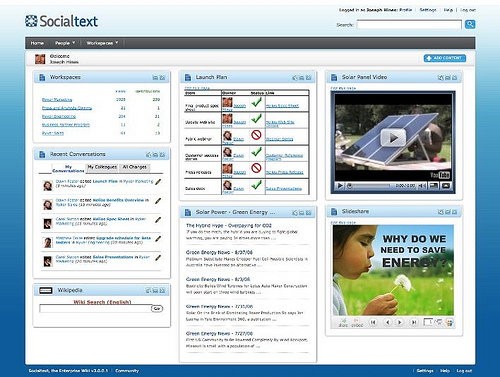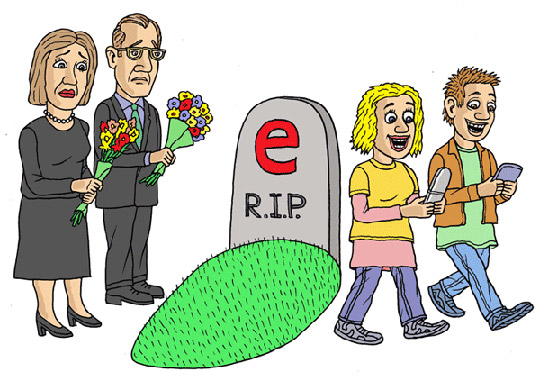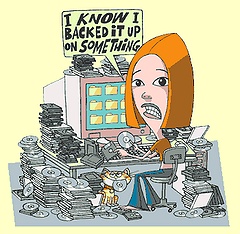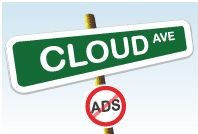Socialtext, the enterprise wiki company is no more… a wiki company, that is. Not since Socialtext 3.0, the new release announced today. Founder and Chairman Ross Mayfield calls his new baby a Connected Collaboration Platform, that’s modular, built on a widget framework, and consists of:
- Socialtext Dashboard – your Communication Central
- Socialtext People – Facebook for the Enterprise
- Socialtext Workspace – originally known as the wiki

A fourth piece, Socialtext Signals is in the works, in private beta testing – I guess we could call it Twitter (Yammer? ESME?) for the Enterprise. Actually more, since it involves active microblogging – quick messages – as well as pulling in what users do elsewhere (FriendFeed?)
The platform is flexible, easy to customize via widgets, clearly the vision is that in an enterprise environment actionable information is pulled in from the transactional systems, too – i.e. ERP, CRM.
Knowing Ross as the uber-social guy something tells me this is what he always wanted to to: create Social Software. But I tend to agree with Jevon MacDonald, who differentiates social software from the wiki, which is primarily a collaboration tool. So Ross was really in the collaboration business and given his name became synonymous with wiki evangelism, he will no doubt have a hard time changing that image. 
This is not to say the wiki part, should be neglected… It is the primary collaboration facility for anything not well handled by process-driven, transactional systems, and all this social layer is just the glue that holds it all together. (Hint: you will hear a lot more about Glue soon).
I had in the past been quite critical of Socialtext’s wiki component, and am looking forward to revisit it, as part of our wiki-series in the coming weeks @ CloudAve. In the meantime, enjoy this video:
Related articles by Zemanta
- SocialText 3.0 blends Facebook, Twitter, and the Enterprise
- Hello Socialtext 3.0!
- Socialtext 3.0: Will Wikis Finally Find Their Place in Business?
- Social(er)text: From Wiki to Wonderkind


![Reblog this post [with Zemanta]](https://www.zoliblog.com/wp-content/uploads/HLIC/1e888c58c2f8097a76d183db620f05dd.png)

 We can argue all we want about the benefits of SaaS, discuss hypothetical use cases at length, but the best showcases are served up by real life, often unexpectedly.
We can argue all we want about the benefits of SaaS, discuss hypothetical use cases at length, but the best showcases are served up by real life, often unexpectedly.  see the benefits of a
see the benefits of a  (OK, I sinned. Mea Culpa. I’ve just cross-posted an entire article, which is not the best behavior. But it’s not every day that I
(OK, I sinned. Mea Culpa. I’ve just cross-posted an entire article, which is not the best behavior. But it’s not every day that I  )
) P.S. The CloudAve platform is not exactly in nice order yet. It’s work-in-progress.
P.S. The CloudAve platform is not exactly in nice order yet. It’s work-in-progress. 
 Then there’s the issue of The Gadget. I believe the iPod at the first conference was just more-then-generous swag. The iPhones handed out at the second conference had an integral part at the event: several applications released specifically for Office 2.0 allowed participants to interact with each other, navigate the schedule and find sessions. This time all paid participants will receive a the HP 2133 Mini-Note PC.
Then there’s the issue of The Gadget. I believe the iPod at the first conference was just more-then-generous swag. The iPhones handed out at the second conference had an integral part at the event: several applications released specifically for Office 2.0 allowed participants to interact with each other, navigate the schedule and find sessions. This time all paid participants will receive a the HP 2133 Mini-Note PC.![Reblog this post [with Zemanta]](https://www.zoliblog.com/wp-content/uploads/HLIC/c3f6a73b6f73860cb3967d8190b33e5c.png)


Recent Comments